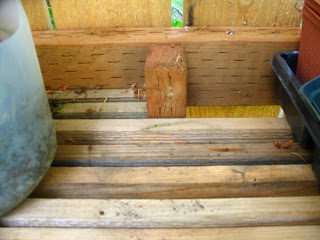Problem 1: Overestimating material requirements. My pond project left me with a substantial pile (2 feet wide, 8 feet long, and 1 foot high) of leftover gravel and rocks (up to 4 inches in diameter). I needed a place to temporarily store this excess rock. (It was crowding our driveway, where we parked four cars.)
I decided the 30-inch wide bare earth strip between the south fence and the sport court could serve as a temporary storage area.
Problem 2: Too much mulch. I already had a large mulch pile that I'd moved close to the north side fence. I'd subsequently covered it over with garden soil and planted potatoes in it. I needed space for the gravel and rock, so I expanded the large mulch pile with excavated dirt from alongside the sport court.
I created a 3-foot tall 8-foot diameter green mound where the worms could play and my potatoes could grow.
Problem 3: Bishop's weed (aka goutweed) takeover. Ever make a gardening mistake? I thought Bishop's weed was pretty--and because it was free, (came through a back fence) I'd allowed that weed to take over a 30-inch wide strip of bare earth next to our sport court. Only later, did I learn the name of the plant. Note: Be suspicious of anything with 'weed' as part of its name.
In the process of uprooting the Bishop's weed a year later, I harvested a couple of huge black plastic bags of the stuff. Don't even consider using it as mulch--takes too long to break down--put it in the trash! I dug deeply enough to completely remove all traces of its invasive roots.
I did move the excavated dirt from the 30-inch-wide strip over to the growing mulch pile and dumped my rock and gravel into the excavated strip beside the sport court. Temporary rock storage problem solved.

Rock and gravel is temporarily stored next to sport court (the dirt mound at bottom right was contributed by Mr. Mole)
A year later, I harvested the potatoes growing in the mulch pile, but the tall earth/mulch pile was an unsightly mound in winter. I needed to spread it around a bit. That's when I first contemplated a permanent raised bed.
Problem 4. Rotting fence boards. I knew I couldn't spread the earth/mulch all the way to the fence, which was already rotting at the bottom from a long-term buildup of organic materials on both sides. I could solve that by purchasing new fence boards, but I had to consider how to protect the replacement fence.
My answer was both simple, economical, and involved the least labor for me: concrete building blocks.
I laid up two courses of concrete building blocks as the back wall of the new raised bed. Concrete blocks aren't pretty. However, my back-of-the-raised-bed block wall is mostly hidden from view by both the dirt in the bed and the plantings growing in the raised bed. The back-of-the-raised-bed wall is fairly close to the wooden fence, but there's still plenty of space for good air circulation at the bottom.

Concrete blocks help keep dirt in the bed and away from fence. Note air gap between fence and blocks.
I had a few large rocks leftover from the pond project and used them to start the front-of-the-raised-bed wall. My block back wall is 12 inches tall and the rock front wall is just slightly shorter.
Problem 5: Digger dog. Our dog likes to dig (surprise, surprise). My son pointed out to me (the day after my rock wall was up) that Cookie dog had dislodged the rocks in a section of the wall. She'd dug in front of and beneath the wall rocks and undermined them. (Seems she was after an invader--a mole.)
To prevent her undermining my rock wall again, I laid down a pathway of compacted gravel in front of the new rock wall. This won't stop her from digging within the raised bed, of course, but my new rock wall is reasonably safe.
Problem 6: Mole. Since Mr. Mole travels from my yard to the neighbors yard and back, it isn't a serious problem for the moment. I'll probably have to trap it (...squish...).







 The completed fence plant container shelving.
The completed fence plant container shelving.

 Rail Support board is notched and screwed to fence rails (top and bottom)
Rail Support board is notched and screwed to fence rails (top and bottom)


